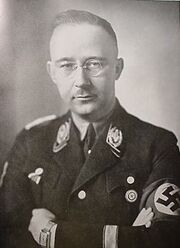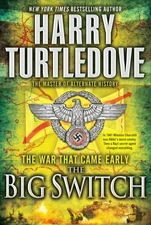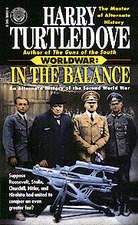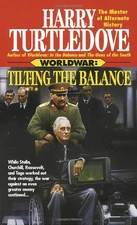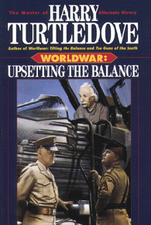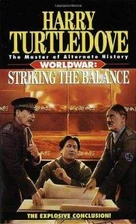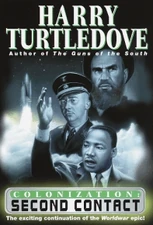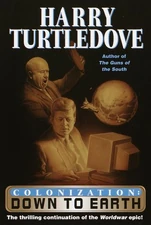| ||||||||||||||||||||||||||||||
Heinrich Himmler (7 October 1900 - 23 May 1945) was head of the SS in Germany during the Chancellorship of Adolf Hitler. He was one of the most powerful men in the country. As Reichsführer-SS, he oversaw all police and security forces.
As a member of a reserve battalion during World War I, Himmler did not see active service. He studied agronomy in university, and joined the Nazi Party in 1923 and the SS in 1925. In 1929, he was appointed Reichsführer-SS by Hitler. Over the next 16 years, he developed the SS from a mere 290-man battalion into a million-strong paramilitary group, and, following Hitler's orders, set up and controlled the Nazi concentration camps. He was known for good organizational skills and for selecting highly competent subordinates. From 1943 onwards, he was both Chief of German Police and Minister of the Interior, overseeing all internal and external police and security forces, including the Gestapo (Secret State Police). Himmler had a lifelong interest in occultism, interpreting Germanic neopagan and Völkisch beliefs to promote the racial policy of Nazi Germany, and incorporating esoteric symbolism and rituals into the SS.
Himmler coordinated the killing of some six million Jews, between 200,000 and 500,000 Romani and possibly another three to four million Poles, communists, or other groups whom the Nazis deemed or simply "in the way". Shortly before the end of World War II, he offered to surrender to the Western Allies if he were spared from prosecution. The Allies declined the offer. Moreover, Hitler learned of Himmler's betrayal, and stripped Himmler of his titles and offices and ordered his arrest. Himmler went on the run, and was captured by British forces. He committed suicide by ingesting a cyanide capsule before he could be questioned. He was buried in an unmarked grave.
Heinrich Himmler in The Man With the Iron Heart[]
| The Man With the Iron Heart POD: May 29, 1942; Relevant POD: May, 1945 | |
| Type of Appearance: | Direct |
Despite his unswerving belief in Adolf Hitler and the Nazi cause, in the aftermath of the Battle of Stalingrad, Heinrich Himmler was persuaded by Reinhard Heydrich to start secreting weapons around Germany in 1943 in preparation for an Allied invasion of the country.[1] He did so without Hitler's knowledge or permission- a dangerous act, given that Hitler refused to believe Germany could ever be defeated.
While Heydrich and Himmler had a degree of mutual respect and worked side-by-side regularly, Himmler had information that suggested Heydrich might have had a close Jewish ancestor- a virtual, if not actual death sentence in Nazi Germany. Thus, while Heydrich was far more physically imposing than Himmler, Heydrich showed Himmler respect and deference.[2]
Himmler was captured by the British in 1945, and committed suicide while in their custody. While Himmler didn't live to see it, his order that an effective resistance be prepared bore fruit almost immediately after Germany fell in May 1945.[3]
Heinrich Himmler in Worldwar[]
| Worldwar POD: May 30, 1942 | |
| Appearance(s): | In the Balance through Down to Earth |
| Type of Appearance: | Direct |
| Date of Death: | 1964 |
| Cause of Death: | Coronary thrombosis |
| Military Branch: | SS (WWII, Race Invasion of Tosev 3) |
| Political Office(s): | Führer and Chancellor of the Greater German Reich |
Heinrich Himmler (1900-1964) held the position of Reichsführer-SS throughout World War II and the subsequent war against the Race following the Conquest Fleet's arrival on Earth in 1942.[4] Following Adolf Hitler's death, Himmler became Führer and Chancellor of Germany.[5] Himmler served in this capacity until his own death in 1964, when he was succeeded by Ernst Kaltenbrunner.
Himmler carried on Hitler's policy of the "Final Solution" to the Jewish question within the borders of the Greater German Reich, disregarding the protests made by the Race. Jews were killed in substantial numbers throughout most of Europe.[6] Himmler lacked Hitler's fiery charisma and had none of his magnetism as a public figure, but his calm demeanor lead many to regard him as far more logical and self-controlled than his predecessor.[7]
A fierce devotee of Nazi ideology and the greatness of the German Reich, Himmler was nonetheless pragmatic enough to avoid war with the Race during most of his rule. However, by 1964, territorial ambition and ideological devotion had gotten the better of Himmler, and he turned his attention back to Race-occupied Poland.[8] At the Peace of Cairo in 1944, Germany had strenuously demanded that Poland be returned to the Reich. However, the course of negotiations left it in the hands of the Race.
While the German government under both Hitler and Himmler had kept quiet on the issue of Poland for two decades, Himmler had convinced himself that Poland must be taken from the Race. In 1964, through his ambassador to the Soviet Union, Paul Schmidt, Himmler offered an alliance to Vyacheslav Molotov and the possible division of Poland. Remembering that the division of Poland merely provided Germany a launching pad to the invasion of the USSR, and knowing full well the dangers of war with the Race, Molotov refused the offer.[9]
Despite Molotov's refusal, and despite warnings from the Race, who detected German troop movements and had learned of the proposal made to the USSR, Himmler pushed ahead with invasion preparations while publicly denying his plans.[10] Not much later, Himmler died at his desk of a coronary thrombosis.[11]
Himmler's successor, Kaltenbrunner, initiated what became the Race-German War of 1965 by invading Poland. The result was devastation to Germany and its empire, proving the foolishness of Himmler's plans.[12]
Heinrich Himmler in In the Presence of Mine Enemies[]
| In the Presence of Mine Enemies POD: c. 1940 | |
| Type of Appearance: | Posthumous reference |
| Date of Death: | 1985 |
| Cause of Death: | Natural causes |
| Political Office(s): | Führer of the Greater German Reich |
The tremendous power that Heinrich Himmler (1900-1985) wielded as the first Reichsführer-SS ensured his ascension as the second Führer of the Greater German Reich upon the death of Adolf Hitler. Himmler led the Reich through the Third World War, defeating and conquering the United States.[13] He also continued the extermination of the Jews, extending the policy to North America.[14]
Himmler's last years saw him in extremely poor health, with only dialysis keeping him going the last five years of his life.[15] A popular conspiracy theory had it that Himmler in fact died in 1983, and that the SS simply kept up the pretense that he was still alive until Kurt Haldweim was made Führer in 1985.[16]
Heinrich Himmler in The War That Came Early[]
| The War That Came Early POD: July 20, 1936; Relevant POD: September 29, 1938 | |
| Appearance(s): | Contemporary references throughout |
| Date of Death: | 1944 |
| Cause of Death: | Killed while resisting arrest (World War II) |
As Reichsführer-SS, Heinrich Himmler (1900-1944) played an important role in Germany after the Second World War broke out in October 1938. His power (and that of the SS) grew as the war continued on, particularly after two separate Putsch attempts in January and then October of 1939.[17] After the first coup attempt, the SS began hunting around the Wehrmacht, looking for traitors, and hauling off anyone suspected of defeatism. This action was seen as similar to the recent Great Purges of the Soviet Army. After the second coup attempt, Himmler was given unprecedented powers, and began installing SS officers in the Wehrmacht, much like the Soviet Political Officers monitored the Red Army.
In 1940, the German government announced that the Jews living in Bohemia and Moravia would be placed into ghettos, a plan to be supervised by Himmler.[18]
However, Himmler's fate was bound to Hitler's, and while the war was going Germany's way, both men were held in high regard. But when the war started going against Germany in 1941, first with the dissolution of the Hess Agreement which had briefly made Britain and France allies of Germany in the war against the Soviet Union from summer of 1940 to winter of 1941, and the expansion of the war to multiple fronts, discontent with Himmler started to grow.
The Nazi government overplayed its hand domestically, provoking rebellion. Münster became a center of dissidence, led in part by Bishop Clemens August von Galen, who was critical of the Nazis' euthanasia programs. The Gestapo arrested von Galen, prompting a round of demonstrations in Münster. In the spring of 1943, another demonstration in the square outside of Münster's cathedral erupted into violence when police officers fired on the crowd. While several protesters were shot, other were able to charge the line of police, inflicting damage in return.[19] In response, German government sent the SS into Münster, who fortified the cathedral.[20] While the people of Münster publicly accepted martial law, resentment towards Himmler as head of the SS boiled just below the surface.[21]
The situation climaxed in the following months. Dissatisfaction with the course of events at home and abroad led to a group of senior military and political leaders to form the Committee for the Salvation of the German Nation. After Hitler declared war on the United States in March 1944, the Committee decided the war was unwinnable and took action.[22] When Hitler gave a broadcast speech in Münster about the insurrection taking place there, a bomb was planted which exploded, killing him. Immediately the Committee took over the radio broadcast and their leader Heinz Guderian announced Hitler's death and that the Committee was taking over.[23] Himmler was targeted for arrest by the Committee,[24] but resisted and was killed.[25]
Heinrich Himmler in Joe Steele[]
| Joe Steele POD: 1878; Relevant POD: July, 1932 | |
| Novel or Story?: | Both |
| Type of Appearance: | Contemporary references |
In 1937, when U.S. President Joe Steele announced the creation of the Government Bureau of Investigation, some in the U.S. likened GBI head J. Edgar Hoover to Heinrich Himmler.[26]
Himmler held his position until the end of World War II. At the end of the war, he was captured by the British, and committed suicide.[27]
Literary comment[]
In the short story, Heinrich Himmler is compared to J. Edgar Hoover, but plays no role otherwise.
Heinrich Himmler in "Zigeuner"[]
| "Zigeuner" POD: c. 1914 | |
| Type of Appearance: | Oblique contemporary reference |
Reichsführer-SS Heinrich Himmler[28] was one of two figures to whom Hauptsturmführer Joseph Stieglitz was loyal unto death, the other being Führer Adolf Hitler himself.[29]
See Also[]
- Heinrich Himmler at The Man in the High Castle wiki.
References[]
- ↑ The Man With the Iron Heart, pgs. 6-11.
- ↑ Ibid., pg. 7.
- ↑ Ibid., see, e.g. pg. 468.
- ↑ See, the Worldwar series, generally.
- ↑ See, e.g., Second Contact, pg. 7
- ↑ See, e.g. ibid., pg. 51.
- ↑ Ibid., pg. 108.
- ↑ Ibid., pg. 207-208
- ↑ Down to Earth, pgs. 254-257.
- ↑ Ibid., pgs. 260-264.
- ↑ ibid., pg. 339.
- ↑ Ibid., pgs. 552-600, generally.
- ↑ E.g., In the Presence of Mine Enemies, pg. 6.
- ↑ Ibid., pg. 16, generally.
- ↑ Ibid, pg. 50.
- ↑ Ibid.
- ↑ See, The War That Came Early series, generally.
- ↑ The Big Switch, pg. 145.
- ↑ Two Fronts, pg. 358.
- ↑ Ibid., pg. 386-387.
- ↑ Ibid., pg. 387.
- ↑ Last Orders, pg. 311, HC.
- ↑ Ibid, pgs. 299-300.
- ↑ Ibid., pg. 300, HC.
- ↑ Ibid. pg, 314.
- ↑ Joe Steele, pg. 151.
- ↑ Ibid., pg. 425.
- ↑ Himmler is not named, but all other high office holders in the story are the same as in OTL.
- ↑ See, e.g., The Year's Best Science Fiction: Thirty-Fifth Annual Collection, pg. 322.
| Titles and Succession | ||||||||||||||||||||||||||||||
|---|---|---|---|---|---|---|---|---|---|---|---|---|---|---|---|---|---|---|---|---|---|---|---|---|---|---|---|---|---|---|
| ||||||||||||||||||||||||||||||
| |||||||||||||||||||||||||||||||||||||||||||||||||||||||||||||||||||||||||||||||||||||||||||||||||||||||||||||||||||||||||||||||||||||||
